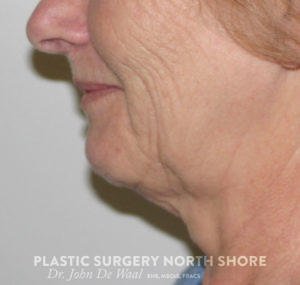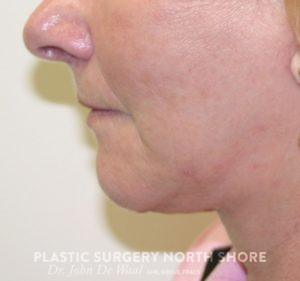Facelift Surgery (Meloplasty)
Rejuvenate your appearance and regain your youthful confidence with a specialised facelift surgery.
Your face goes through various gradual changes as you age; tissue degeneration results in the loss of elasticity, skin tone and facial volume, and the development of wrinkles, jowls and sagging skin. A facelift procedure repositions the underlying muscle tissues, tightens your skin and removes the obvious signs of ageing. The best plastic surgeons can ‘turn back the clock’ by ten years on your appearance, without making it look like you’ve had ‘work done’.
If you’re considering a facelift in Auckland and looking for the most refined results possible, here’s what you need to know about Dr John de Waal’s tailored approach.

What is a facelift?
A facelift (also known as a Meloplasty or Rhytidectomy) is a cosmetic surgery that helps to correct the signs of ageing in the face and neck. The aim is to refresh your appearance by tightening, lifting and restoring volume to your face.
Surgical understanding of complex facial structures has dramatically increased in recent years, and today’s techniques deliver a more natural looking, effective facelift than ever before. Facelift procedures used to focus on simply stretching the wrinkled surface of the skin; however, we now also reshape and tighten the underlying layer of connective tissue, called the SMAS, to deliver advanced, longer-lasting results. We use old photos of you from your 20s and 30s to sculpt and shape your face to achieve youthful contours that still look like ‘you’.
Types of facelift surgery
There are several types of facelift procedures, and many patients often enhance their results with complimentary facial surgeries.
Traditional facelift surgery
A standard facelift, also referred to as a full facelift or traditional facelift, is a comprehensive surgery that targets the lower two-thirds of your face, and your neck. It is often performed in conjunction with a neck lift, brow lift, blepharoplasty, facial fat grafting or a lip lift.
During your consultations with plastic surgeon Dr De Waal, we will determine whether SMAS or deep plane facelift techniques are right for you. With either technique, we can dramatically improve the signs of moderate to advanced ageing around your eyes, remove sagging skin on your cheeks, chin and neck, tackle frown lines around your mouth and restore structure to your cheekbones and jawline.
Mini facelift surgery
A ‘mini’ facelift surgery is a less invasive version of a traditional facelift. It is also known as a ‘short-scar facelift’, ‘S-lift’ or ‘MACS lift’. It focuses on the lower third of the face, so it is best suited to people who are more concerned about their jawline than their jowls, cheeks or eyes. The surgery involves less manipulation of deep tissue, so results are less drastic. However, scarring is minimal, and the procedure can be performed under local anaesthetic.
Procedures often combined with a facelift surgery
Patients often choose to enhance their facelift with additional facial procedures.
Brow lift
A brow lift reduces the horizontal wrinkles on your forehead, lifts your eyebrows and corrects the deep frown lines that can form between your brows.
Blepharoplasty
A blepharoplasty lifts and removes excess skin from ‘baggy’ or ‘drooping’ upper eyelids and under-eye bags. This eyelid surgery procedure makes you look significantly younger and well-rested.
Neck lift
Your neck is often the first area to show the effects of age, gravity and sun exposure. A neck lift removes the ‘turkey gobbler’ effect, redefines your jawline, improves wrinkles and skin tone and removes excess fat.
Lip lift and facial fat grafting
Fat grafting is a surgical technique that can help reverse the gradual loss of volume in your cheeks and lips. If you are concerned about hollowed cheeks or thinning lips, dermis tissue can be taken from easily hidden areas of your body to restore fullness to your face and fill in fine lines.
Asking questions and knowing what to expect on operation day is an important part of the facelift procedure.
Before the surgery in Auckland, Dr de Waal will talk you through the operation and draw planned incisions on the area to make sure that they align with your expectations and what has been discussed in the consultation. You’ll then be placed under general anaesthesia before the facial operation takes place.
During the surgery, your skin is lifted by gentle dissection and the deeper SMAS support structures are lifted and repositioned. Your skin is then repositioned and any excess skin is removed. We will then carefully suture your incisions to ensure minimal scarring.
The procedure will vary according to your bespoke treatment plan, but your facelift surgery will likely take 3-6 hours.
Will I get scars from a surgical facelift?
The scars from a facelift will be hidden within your hairline, but regardless our highly skilled surgeons will make sure your scars are barely noticeable and heal impeccably.
Dr de Waal takes special care in every operation, using advanced techniques and his extensive experience to ensure minimal scarring and bruising to help with recovery. Here’s what to expect after a traditional facelift:
- To ensure a smooth facelift recovery process, we recommend 1-2 nights of hospital stay. During this time we will keep the area bandaged or compressed.
- It is best to plan about 3-4 weeks of time off work/activities.
- We will make an appointment to remove your stitches after 5 days. Sometimes, we postpone the removal depending on how your healing is progressing.
- Any bruising or swelling will generally settle within 2-3 weeks. After this, people likely won’t be able to guess that you have had a surgery!
- You may experience temporary numbness, mild pain or tightness on your face and neck; this should dissipate within 6-8 weeks.
*recovery times are approximate and dependent on the individual and their procedure.
Implications for any surgery are typically unlikely with proper care. However, like all surgeries, there is always a risk of bleeding, infection and bad reactions to anaesthesia. Typically, hazards are minimal for healthy facelift candidates who follow pre-surgery and post-op instructions.
Common (temporary) facial plastic surgery risks:
- Bruising
- Swelling
- Temporary numbness
- Discomfort on movement/coughing
Infrequent facial surgery risks:
- Infection
- Bleeding (haematoma)
- Delayed healing
- Poor scarring
Before any procedure, Dr de Waal will discuss any potential risks and make sure that you fit the profile of a healthy tummy tuck candidate.



